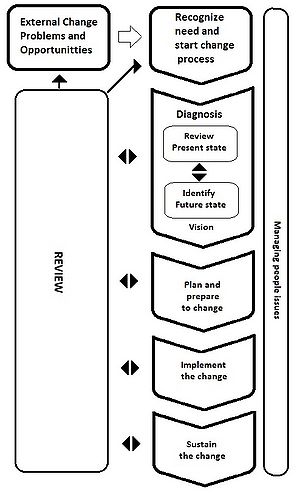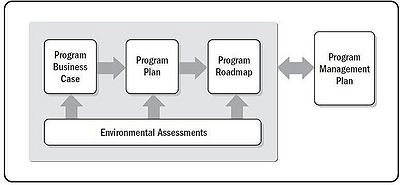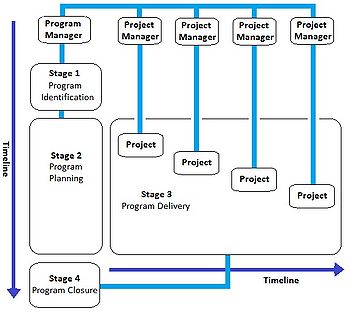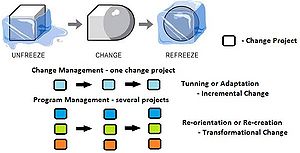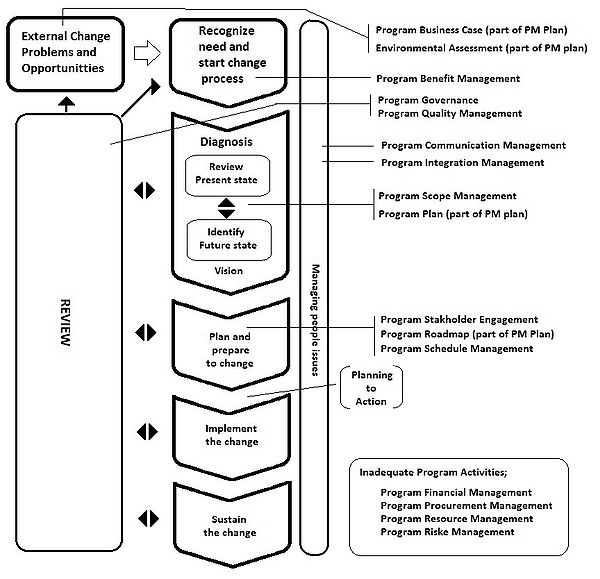Talk:The Role of Program Management in an Organisational Change
Developed by Sebbe Sidenius Bull
Revised by Cirkeline Bräuner
ADD REFERENCES, AND PURPOSE/PEOPLE/COMPLEXITY/UNCERTAINCY
In today's rapidly changing society, organisations are going through changes all the time. This causes, that organisations must be able to adapt to new market conditions, changing customer demands and emerging technology. To remain competitive, many organisations go through changes such as process optimisation, cost reduction or technology adoption. These are few examples of changes which affect the entire business, and it is therefore crucial that the change is managed in a successful way to not harm the business.
Organisational change is a huge alteration for any organisation and can be a dawning task if not managed properly. In the context of project management, organisational change refers to any significant alteration in an organisation that affects the way projects are planned, executed, and managed. Project managers must be able to identify the potential impact of organisational changes in their projects and adapt their project management approach accordingly to ensure successful project delivery. In this regard, program management can serve as an effective tool for managing organisational change. With its comprehensive toolbox of evaluative methods, program management offers a structured approach to assessing each potential change project. This toolbox supports change managers in providing an overview of the change project, ensuring efficient project execution, promoting project alignment, evaluating risks, mapping stakeholders and identifying potential benefits. All of these elements work together to facilitate a more effective and efficient change management process.
This article provides an introduction to what change management is and why it is a difficult task to manage. Afterwards, an introduction to program management is given. Then, the two management fields are combined into one common understand of how program management can be applied in organisational change. Lastly, the benefits and limitations of organisational changes using program management is discussed.
Contents |
Change management
What is a change?
What is change management?"
Unfortunately, there is not a single recipe for applying change management in organisations as the subject is simply too complex. However, all organisational change process can be described through the following simple four-step process:
- Assess the need for change: Recognise that there is a problem and identify the source of the problem.
- Decide on the change to make: Decide what the organisation's ideal future state would be and identify obstacles to change.
- Implement the change: Introduce and manage change and decide whether change will occur top down or bottom up.
- Evaluate the change: Compare performance and use benchmarking.
MAKE A BETTER CONNECTION HERE
CHANGE LEWINS MODEL
One of the most simplified way of viewing the change process is through Kurt Lewin's three-step change process [1]. As illustrated in the figure, the change process is divided into three distinct stages; freeze, move and refreeze.
- Unfreeze: The first stage characterises the starting point of the change process where the organisation prepares for the change. This involves creating awareness about the need for the change, identifying current behaviours and to get people to let go of their old ways of thinking and working [2].
- Change: The second stage involves implementing through planning, communication and execution. The objective is to create new ways of thinking and working. During this phase, people must be trained and educated to adopt new methods and behaviours and to overcome any obstacles that may arise [3].
- Refreeze: The third stage addresses making the new change permanent. The objective is to reinforce the new behaviours, ensuring that they become a part of the organisation's culture. During this phase, the focus is on stabilising the new ways of thinking and working, and creating a sense of ownership among employees [4].
Why is it difficult to manage change?
Changes are often managed less effectively and efficiently than it might be because those responsible for managing it fails to attend to some of the critical factors and aspects of the change process. This issue have already had its impact on organisations whose employees have had bad experiences with change initiatives and are more reluctant to change than others. To enable managers to cope with change, the Key Steps In the Change Process are presented [5].
At first glance, it seems like change is a rational and linear process. Nevertheless, this is rarely how it unfolds in practice. The model is a systematic process that guide managers through all the relevant stages that a change initiative have to take into account from planning to implementation. One of the key aspects in the change process is reviewing and managing people issues throughout the entire process. Which are the most important factors for the managers to contemplate and manage when initiating in an organisational change, due to the fact that employees are the one whom are able to make the organisational change possible.
Another Perspective - Survival of the fittest We all know Darwin´s evolutionary theory[6], including the theory of natural selection. In 1864, Herbert Spence interpreted Darwin´s theory into the financial world, and came up the more popular phrase Survival of the fittest[7]. This might seem fare fetched from organisational change. Nevertheless, organisations have a huge range of operations and systems, which interconnect, but also operate independently - much like the animal kingdom.
The point here is that when an organisation develops a re-orientation or a re-creation of the company, it is time to kill your darlings and manage the change to ensure survival of the fittest operations and systems. A less impactful change can be adopted on strong operations to ensure their survival in the future. Thus making the company future-proof. Another important aspect - previously stated - is managing people issues. If a manager cut an operation of the agenda, the employees feels dumped. Why it is important for the whole organisation to understand that, "the overall system gets stronger when some components are destroyed or replaced by others" - Nassim Taleb [8]. Here, managers should strive for social coherence and acceptance throughout the entire organisation, to ensure that all parts of the organisation is as ready as possible for the change ahead.
Their are many challenges regarding organisational change. Managers in charge of the operation, must research, analyse and handle challenges carefully in order to succeed. Nevertheless, there are some key factors which must be taken into acount:
- Human Behaviour
- Planning
- Execution(Implementation)
Following links will show a range of challenges in different perspectives; Factors which cause failure in Change Management [9]. Barriers in Change Management [10], [11]. Best Practice challenges in Change Management [12], Human Resource Best Practice in organisational change [13].
To elaborate, some of the key factors of success are;
- Clear objectives and a plan to get there
- The right team to execute the change
- Openness, Team spirit within the organisation
- Communication throughout the change process
- Support thoughout the change process
- Motivation towards the change
- Employees must be handled with care
- Sufficient Time to execute, implement and sustain
Further investigation on the change process will not be conducted in this article. Relevant literature for managing change are presented here;
- 2010, The Theory and Practice of Change Management, John Hayes.[14]
- 2011, Facilitation Change, Lauge Baungaard Rasmussen.[15]
- 1996, Leading Change, John P. Kotter. [16]
Planning an organisational change is both complex, full of human behaviour and uncertainties, which all draws a line towards Program management. Following section will describe the basis of Program Management.
Program Management
A program is a set of projects identified by a given organisation that will deliver a defined objective. Roughly speaking, a project provide deliverables, program provide benefits and portfolio provide strategic guidance [17]. A program can only succeed if the projects within the program are completed, and without it the projects will be uncoordinated and not integrated in the final goal. Program management is a structured way of managing change initiative and be proactive towards change, moreover it provides a solid framework for handling complexity and risks [18].
Program Management provide following benefits;
- Definition of projects to generate deliverables that together will provide the desired benefit.
- Active coordination of project execution.
- Effecient execution (common governance and processes).
Further difinition of the concept[17];
- Goal; Deliver benefit: High level objective comprised of multiple deliverables.
- Role of Change; It is pro-active and adaptive method which focus on an evolving understanding of benefits, capabilities and environment.
- Relatedness of components; While sub-projects create physically distinct deliverables, there is a strong mutual dependence.
- Planning; Life-cycle perspective to develop definition of deliverable.
- Time Scale; Duration of system lifecycle: Years to 10s of years.
- Effeciency; Coordination among projects.
- Effectiveness; Understand and operationalize “benefits”.
Tools and Methods
Program Managements Performance Domain
This section is a overview of Program management and what management-tools it consist of. The range of tools will help to determine the role of Program management in an organisational change, presented in Application of Program Management In an Organisational Change.
PMI(Project Management Institute)[1]: Standard for Program Management, 2013, state following domains which Program management interact with [19]. Each domain holds different tools and methods which all are useful for managers to cope with Program management in general. The four elements features; Program Strategy Alignment, Program Benefit Management, Program Stakeholder Engagement, Program Governance and Program Life Cycle Management, each will be explained in the sections below.
Program Strategy Alignment
Strategy alignment will support managers in identifying opportunities and benefits to achieve the organization's strategic objectives through program implementation. For managers to ensure a strategic alignment, the Elements of Program Strategy Alignment is a structured way to get there, it consist of the four elements illustrated in the figure.
- Program Business Case, asses balance between costs and benefits of the program. A detailed description of the value the program are to deliver and justification of the resources used in the program. Other relevant elements; details about problems or opportunities, business and operation impact, cost benefit analysis, alternative solutions, financial analysis, potential profit, social need/coherence, risks and the programs alignment towards the organisations strategic objects.
- Program Plan, is the clarification of the organisation´s concept, vision, mission and benefits created by the proposed program. Furthermore it defines goals and objectives.
- Program Roadmap, describe dependencies between major milestones, illustrate the link between planned work and business strategy, reveal gaps (lost time), highlights milestones, summarize objects, challenges and risks, indicate required infrastructure.
- Environmental Assessments, help managers to understand the surrounding environment, understand opportunities and threats that are to be exploited and/or mitigated by the program. Other relevant elements would be; SWOT analysis, SWOT matrix [20], relevant historical information, analysis and documentation of key assumptions.
Program Benefit Management
Defining, creating, maximizing, delivering, and sustaining the benefits provided by the program. Other relevant elements; benefit identification, benefit analysis and planning, benefit delivery, benefit transition and benefit sustainment.
Program Stakeholder Engagement
Capturing and understanding stakeholder needs, desires, and expectations and analysing the impact of the program on stakeholders, gaining and maintaining stakeholder support, managing stakeholder communications, and mitigating/channelling stakeholder resistance. Identifying and prioritising stakeholders, usually done in a stakeholder map through a stakeholder analysis. Further information can be found in stakeholder analysis process. Stakeholder engagement plan is a potent solution to how an organisation should interact with each stakeholder group, regarding communication, consultation and their role in execution.
Program Governance
Establishing processes and procedures for maintaining program management oversight and decision-making support for applicable policies and practices throughout the course of the program. Program Governance is needed cause it provide the basis of, decision making, alignment of objectives, funding, communication, control and supporting activities. Supporting activities could consist of; program management office, program management information system, knowledge management, auditing support and education and training.
Program Life Cycle Management
Managing all of the program activities related to program definition, program benefits delivery, and program closure. Program Life Cycle Management is the cornerstone and interact with all the subjects mentioned above.
There are three phases within Program Life Cycle Management, which will be briefly described; More information can be found in Life Cycle Model.
- Program Definition, is needed to elaborate on business case, conduct feasibility studies and trade-off analysis, iterative development of business case, program plan and program roadmap and hereby create the basis for approval of the program.
- Program Benefit Delivery Phase, execute the bulk of the program work aimed to deliver the desired benefits.
- Program Closure Phase, ensure a controlled ending of the program. Here it would be beneficial to document best practice and lesson learned.
To end this chapter about Program management a list of relevant support activity is listed. Program Communication Management, Program Financial Management, Program Integration Management, Program Procurement Management, Program Quality Management, Program Resource Management, Program Risk Management, Program Schedule Management and Program Scope Management.
The need of support is huge when engaging in an organisational change, and managers must pick and chose in relation to what components will have the highest amount of value. Before initiating on the application of Program and Change management a generic framework for a program is presented.
Program Management - Stage Model
A set of related projects not managed as a program are likely to run off course and fail to achieve the desire outcome [21]. It is important that programs run within a framework that ensures there is a focus on the overall strategic objectives. Applying the Program management within a framework is crucial to control and implement. Program managers have developed a wide range of frameworks, one framework have been chosen called; Program Management Stage Mapping. The model illustrate how an organisation can visualise their program and furthermore it illustrates four stage, which will briefly be introduced [21].
- Stage 1: Program Identification, is where the strategy and direction of the company is decided. A program plan is produced, to outline the business case, alignment to strategy, scope and the expected objectives and benefits.
- Stage 2: Program Planning, is where the design of the program is takes place. Program manager should establish following; define clear objectives, agree on approach, agree on roles and responsibility, set-up communication channels, agree on priorities of projects within the program.
- Stage 3: Program Delivery, is an ongoing process alongside the projects. Program managers monitor the progress, assess risks and report to committee. Moreover, it is important that the Program manager ensure that projects are aligned with objective and strategy.
- Stage 4: Program Closure, is done when objectives and benefits are reached. As a final task Program managers must review the entire process, and document lesson learned. Every stage can conduct more or less models and methods, which are up to the managers and the organisation as a whole to decide.
Application of Program Management in an Organisational Change
“Program Management is a structured framework for defining and implementing change within an organization” - James J. Leal[22]
As J. Leal point out, the structured framework of Program management is a helping hand to implement several change initiative in an organisation. In order to illustrate this aspect, a range of change projects is setup alongside Lewins Three steps. The generic approach towards a change project, will have effecient execution towards one or two change initiatives, which provide the organisation with an Incremental change. By applying the structure, overview and transparency from Program management will allow the change to become even greater and more comprehensive - which is refered to as a Transformational change. Seen from another perspective, Program management often produce changes in its being - hence it consist of a range of projects, and is used widely in the modern business world.
To further investigate where Program management benefit and have impact on an organisational change - the methods and tools from Program management is presented alongside Steps In the Change Process.
First of all the model illustrate that there is alot of simularities in how the two management fields initiate on a project. Note that Program management will have a range of projects. Secondly, Program management have no tools regarding implementing change. Thirdly, Change management lack the financial approach.
Life Cycle Management has been neglected in the model. Hence, it controls the overall project, ensuring benefits and a controlled ending of the change program. Which is important to sustain the overall change in an organisation.
Contribution of Program Management
Inadequate Program Activities, seen in the figure, is what the change process lack. It is clearly seen that the steps in a change process neglect most of the financial part. Which is very important aspect if an organisation plan to re-orientate or re-create their organisation. Moreover, the wide range of analysis, planning and activity tools within Program management will definitely support the overall change process, by structuring and plan in great detail. This is important, course when an organisation engage in an organisational change you have to make sure that the company survive the change and benefit from it.
Contribution of Change Management
Change management recognise that people within the organisation is one of the most important aspect of a success full change. Why people issues is relevant throughout the entire change program. While most of the structure is done within Program management – Change management on the other hand, have a great deal of knowledge about implementation, and will support the Program managers by addressing the right issues when engaging in an organisational change.
Using the framework from Program management and applying crucial factors recognised by Change management, will definetly ease an organisational change. Thus making the implementation and followup more focused and smooth.
Key Steps In a Change Process - is a generic approach towards change initiatives - and are not suited for a range of change initiatives, hence it lack overview and transparency between change projects. The role of Program management, is hereby to enable Key Steps In a Change Process to arrange several change projects and activities to run simultaneously - a precondition to enable a re-creation or a re-orientation of an organisational change. Moreover, the benefit- and risk- analysis, roadmapping, stakeholder engagement and overview - provided by Program management - serve as a safty line when initiating in an organisational change.
A Program manager and a Change manager cooperating to establish an organisational change is potentially a success, hence each of their expertise support each other. It is important to note, that for example a Change manager in an organisational change, of course plan and review the costs. Counter wise, a Program manager do know about human behaviour. Nevertheless, the focus is different. Why the focus of the two approaches fused together makes a potent cooperation to manage a successfull organisational change.
References
- ↑ [Hayes John (2010). The Theory and Practice of Change Management. 3rd ed. New York: PALGRAVE MACMALLIN. 29.]
- ↑ [Kotter J.P. (1996) Leading Change, BOSTON, Harvard Business School Press]
- ↑ [Hayes John (2010). The Theory and Practice of Change Management. 3rd ed. New York: PALGRAVE MACMALLIN. 26.]
- ↑ [Hayes John (2010). The Theory and Practice of Change Management. 3rd ed. New York: PALGRAVE MACMALLIN. 27.]
- ↑ [Hayes John (2010). The Theory and Practice of Change Management. 3rd ed. New York: PALGRAVE MACMALLIN. 47.]
- ↑ All About Science, Darwins Theory of Evolution, November 2014
- ↑ Education Portal, Survival of The Fittest & Herbert Spencer, November 2014
- ↑ Nassim Nicholas Taleb, Antifragile: Things that gain from disorder, min 37, December 11, 2012
- ↑ Educational Business Articles, Change Management issues and those factors which cause failure, November 2014
- ↑ The Manager, Problems in Managing Change, Oliver Recklies, August 2001
- ↑ Change drivers, The Challenges of Change Management, Alan Ward, November 2014
- ↑ Key Partners, Challenges of Organizational Change, Stan Nabozny, November 2014
- ↑ American Management Association, HR Best Practices During Organizational Change, June 2014
- ↑ Amazon, The Theory and Practice of Change Management: Third Edition, 2014
- ↑ Saxo, Facilitating Change Using INTERACTIVE METHODS in organizations communities and networks, 2011
- ↑ Amazon, Leading Change, 1996
- ↑ 17.0 17.1 [DTU Management Engineering, Engineering Systems Group, Prof. Oehmen J., Lecture 6-Introduction to Program Management]
- ↑ Project Smart, Robert Norton, November 2014
- ↑ Project Management Institute, 2013
- ↑ MindTools, SWOT Analysis, November 2014
- ↑ 21.0 21.1 Project Smart, A Framework for Program Management, Duncan Haughey, September 28 2009
- ↑ Project Smart Programme Management A Structured Framework for Implementing Change, James J. Leal, 2009

